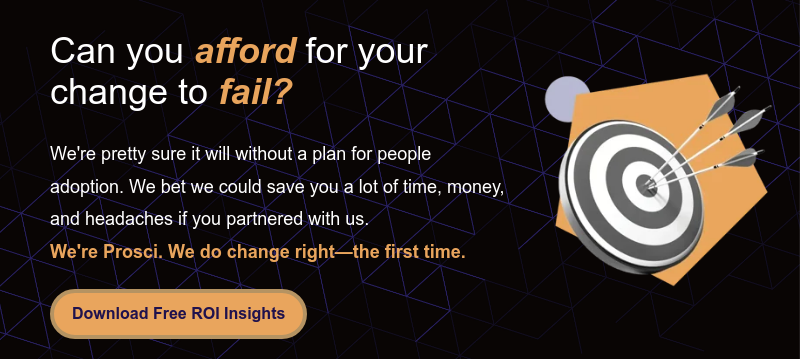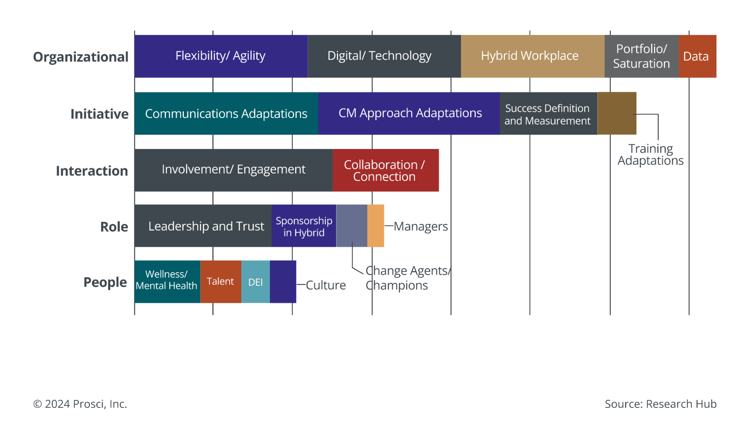
Prosci research on emergent contributors to change success reflects this reality, revealing culture change management as one of the top five contributors to long-term success in the post-pandemic era.
Contributors to Success That Are Emerging or Growing in Importance
Managing Culture Change Effectively
Your first step toward successful change is to understand what’s changing. In rapidly evolving industries, aligning culture change initiatives with broader business strategies is crucial. During culture changes, we advise clients to break down the initiatives into specific behaviors. What are you actually asking people to do differently? The closer their behaviors connect to the outcomes of a strategic initiative, the more credibility they have. Typically, it also allows behavior to connect to the bottom line.
We recommend utilizing the Prosci 10 Aspects of Change Impact model to capture a yesterday-versus-tomorrow view to understanding what's changing.
Prosci 10 Aspects of Change Impact

While each impact of the 10 aspects is key in building your change plan, leadership should focus on critical behaviors and mindsets.
Critical behaviors: Your key to immediate change
Critical behaviors are the near-term changes you want to see in your organization's culture. These require a senior-level leadership commitment. Leadership's active and visible display of these behaviors is essential for long-term behavior changes to take hold in people across the organization.
Using sponsor coalitions and change agent networks is critical for instilling the behaviors you're looking for while supporting the people who must adopt them.
Example: Steps to deploying culture change management in DEI
An organization wanted to encourage more inclusive meetings as a part of its diversity, equity, and inclusion (DEI) initiative. Prosci helped the organization successfully implement the change by following these steps:
- We spoke with employees across the organization to better understand what inclusion meant to them and how they would like to be included. This helped both define a future vision and identify early adopters.
- Once senior leaders outlined these new principles, we could enlist a coalition of other leaders and use them as change agents to demonstrate early wins.
- This approach helped employees to experience the new culture being implemented by influential networks.
The positive outcomes showed up in that year's engagement survey six months later.
Mindset shifts: Long-term goals
Changing how employees think and act at work takes time. It usually takes about 18 months for mindset shifts because everyone needs to start doing things differently and make that the new normal. The key to making change easier is using a common change management language. Working together towards change is easier when everyone understands the same terms and ideas.
Prosci uses this approach to implement change management within organizations. Our goal is to build a change-ready culture where everyone is familiar with:
- The Prosci ADKAR® Model – Awareness, Desire, Knowledge, Ability and Reinforcement. It's a sequential framework that enables people to move through their individual transitions, break through barriers, and get the support they need for success.
- The CLARC roles for people managers – Communicator, Liaison, Advocate, Resistance manager and Coach. Communicators share information, liaisons connect different groups, advocates champion the change, resistance managers remove barriers to change, and coaches help guide everyone. Individual contributors know their roles and can support the outcomes during change.
- Executives perform the ABCs of Sponsorship – Active and visible participation throughout the change, Building a coalition of sponsorship, and Communicating support and promoting the change to impacted groups.
The first step is ensuring everyone knows why the change is happening and wants to help make it happen. Then, training helps everyone understand how to make the change work individually. With effective change management, people from all levels of the organization can be successful in adopting a culture change.
4 Tips for Effective Culture Change Management
 Culture change management strategies include establishing a clear vision, building capabilities, and promoting a belief system that aligns with the organization's goals.
Culture change management strategies include establishing a clear vision, building capabilities, and promoting a belief system that aligns with the organization's goals.
1. Communicate openly
Effective communication involves employees in the change process, thereby earning their support. Don't just disseminate information. Create dialogues, take employee feedback, understand concerns, and address them constructively.
During a culture change, it's critical to celebrate the behaviors you are looking for from employees. Continue to reinforce senior leaders visibly displaying these behaviors yourself. It shows that employees who want to succeed in this company should behave this way.
2. Involve middle management
Middle management, and especially people managers, acts as the crucial link between executive vision and the workforce. A bottom-up approach ensures that the perspectives and insights of employees at all levels inform and shape the change process, making it more inclusive and sustainable.
Leaders should actively and visibly display the behaviors and cultures your organization wants to see. This includes building this culture into your recruiting and onboarding tactics. It should also be part of the performance goals for all leaders.
3. Gamify the transition
 You can beat complacency by bringing in changes gradually and making it fun so the transition is less daunting. Enhancing the employee experience is also key, as it creates a positive and receptive environment for change.
You can beat complacency by bringing in changes gradually and making it fun so the transition is less daunting. Enhancing the employee experience is also key, as it creates a positive and receptive environment for change.
4. Address resistance to change proactively
Resistance to change often stems from a lack of understanding or fear of the unknown. Here are some possible scenarios for resistance and ways to deal with them:
- Mergers – Determine which behaviors you want to retain from each merging company. Crafting a new, unified narrative helps align employees with the envisioned culture.
- Mass layoffs – Being as transparent as possible and being quick about it. Creating plans for people managers to have conversations with employees who remain with the organization.
- Losing a founder – Quickly shaping a vision and creating a culture where employees see themselves building the future.
- Sudden shift to remote work during emergencies – During the mandatory shift to remote work, staying calm, listening to employees, being transparent, and providing support have proven crucial in adapting to the new norm.
- Incorporating diversity, equity and inclusion (DEI) – Starting with a common language helps overcome preconceived notions and unify the workforce under shared goals.
The Prosci Methodology and tools, as well as the Prosci Change Management Certification Program, offer structured approaches to managing culture change in the workplace.
5 Key Strategies for Culture Change With Prosci
Get started on a successful culture change by following these steps:
- Share your vision – Start defining and sharing your goal for change, ensuring everyone knows the direction.
- Engage leaders – Get your leaders involved to lead by example, following the ADKAR Model for support.
- Promote openness – Encourage everyone to share their thoughts and feedback, building trust and easing the change process.
- Celebrate achievements – Acknowledge and reward the behaviors that align with the new culture to motivate everyone.
- Adjust as needed – Keep an eye on progress and be ready to fine-tune your strategy based on what you learn.
Applying these strategies will enhance your ability to steer culture change in the workplace effectively.
Case Studies Showing Culture Change Management in Action
Let's look at two businesses that deployed culture change management successfully with help from Prosci.
SURA Asset Management
SURA Asset Management navigated significant regulatory changes and embarked on disruptive projects, including digitizing their pensions department and introducing a flex-office initiative. Recognizing the critical role of change management in these endeavors, SURA partnered with Prosci Global Partner Faculta (now Prosci Latam-Iberia) to enhance its change management capabilities.
Through role-based Prosci training for key personnel and leveraging the Prosci Advisory Services, SURA:
- Expanded its client base
- Decreased its client turnover
- Increased its pension enrollments
- Reduced operational costs by $240K
- Gained $706K in customer loyalty and retention savings
SURA Asset Management's successful use of Prosci change management strategies led to major savings, more clients and better retention, showcasing what happens when you apply change effectively.
Florida Hospital
Florida Hospital effectively adopted extensive systems and departmental changes by integrating the Prosci change management tools and the Prosci Methodology.
The hospital invested in Prosci change management training for its staff, led by a dedicated change practitioner.
The strategy successfully:
- Created a culture of change at all levels of the organization
- Trained over 100 practitioners
- Helped employees understand in the theoretical aspects and practical applicability of change management
Charting the Path Forward to Successful Culture Change Management
Navigating enterprise culture change management is a complex yet achievable endeavor. Aligning change with broader business strategies, involving the workforce, and leveraging tools like the Prosci ADKAR Model offer a solid path to success. No matter where you are on your journey, an effective approach to change management helps you build an adaptable, resilient organizational culture that can thrive under constant change.






